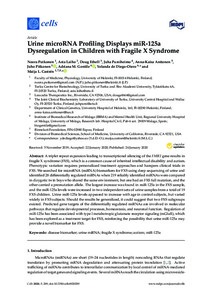Urine microRNA Profiling Displays miR-125a Dysregulation in Children with Fragile X Syndrome
Noora Putkonen; Asta Laiho; Doug Ethell; Juha Pursiheimo; Anna-Kaisa Anttonen; Juho Pitkonen; Adriana M. Gentile; Yolanda de Diego-Otero; Maija L. Castrén
Urine microRNA Profiling Displays miR-125a Dysregulation in Children with Fragile X Syndrome
Noora Putkonen
Asta Laiho
Doug Ethell
Juha Pursiheimo
Anna-Kaisa Anttonen
Juho Pitkonen
Adriana M. Gentile
Yolanda de Diego-Otero
Maija L. Castrén
MDPI
Julkaisun pysyvä osoite on:
https://urn.fi/URN:NBN:fi-fe2021042823664
https://urn.fi/URN:NBN:fi-fe2021042823664
Tiivistelmä
A triplet repeat expansion leading to transcriptional silencing of the FMR1 gene results in fragile X syndrome (FXS), which is a common cause of inherited intellectual disability and autism. Phenotypic variation requires personalized treatment approaches and hampers clinical trials in FXS. We searched for microRNA (miRNA) biomarkers for FXS using deep sequencing of urine and identified 28 differentially regulated miRNAs when 219 reliably identified miRNAs were compared in dizygotic twin boys who shared the same environment, but one had an FXS full mutation, and the other carried a premutation allele. The largest increase was found in miR-125a in the FXS sample, and the miR-125a levels were increased in two independent sets of urine samples from a total of 19 FXS children. Urine miR-125a levels appeared to increase with age in control subjects, but varied widely in FXS subjects. Should the results be generalized, it could suggest that two FXS subgroups existed. Predicted gene targets of the differentially regulated miRNAs are involved in molecular pathways that regulate developmental processes, homeostasis, and neuronal function. Regulation of miR-125a has been associated with type I metabotropic glutamate receptor signaling (mGluR), which has been explored as a treatment target for FXS, reinforcing the possibility that urine miR-125a may provide a novel biomarker for FXS.
Kokoelmat
- Rinnakkaistallenteet [27093]
